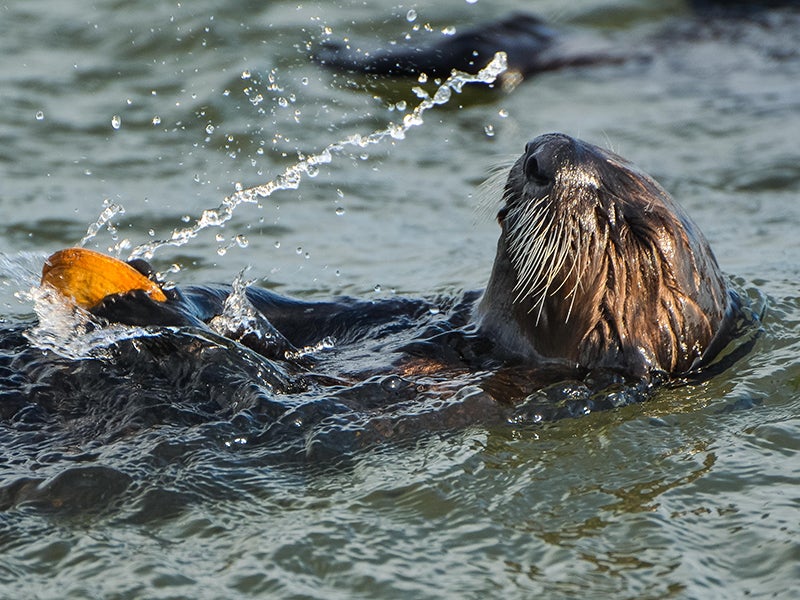Court Calls Third Strike on Industry Challenges to Decision to End Failed Otter Translocation and “No Otter Zone” Program
Victory
—Court of Appeals upholds U.S. Fish & Wildlife Service decision to end failed ‘No Otter Zone’ program meant to exclude sea otters from their historic range along the southern California coast
Contact
Today, the Ninth Circuit Court of Appeals upheld two District Court decisions to end a failed government program known as the “No Otter Zone.” The U.S. Fish and Wildlife Service had determined the program would harm the California sea otter by excluding the animals from their historic range along the southern California coast.
“This decision should put an end to misguided efforts to reinstate the failed ‘No Otter Zone’ program,” said Andrea Treece, the Earthjustice attorney who argued the case. “Ending the No Otter Zone was the right thing to do to protect the California sea otter, and today the Court affirmed that. Otters are an irreplaceable part of our coastal ecosystem—otters need kelp forest and seagrass habitat, and those habitats need otters. The Court’s decision helps the sea otters and coastal habitats by allowing otters to expand their population southward without human interference.”
Several fishing industry groups sued the U.S. Fish and Wildlife Service, arguing that it was obligated to continue to implement the “No Otter Zone,” even after the agency determined that doing so would jeopardize the species’ chances at survival and recovery. Two district courts ruled against the industry groups, and they appealed the previous rulings.
“This decision is a win for sea otters and endangered species everywhere,” said Anna Frostic, managing attorney for wildlife and animal research for The Humane Society of the United States. “The court reinforced that the government has the obligation to amend or terminate a program when it is no longer helping the imperiled species that the government is required to protect.”
In today’s opinion, the Ninth Circuit ruled against these industry groups, confirming that the agency acted fully within its authority by ending the experimental sea otter translocation and management program when it determined it was preventing sea otter recovery rather than promoting it.
“The Court’s decision confirms that the Fish and Wildlife Service made the right decision to let sea otters expand their range naturally, without artificial barriers. If this species is to recover, wider distribution throughout the historic sea otter range is essential,” said Friends of the Sea Otter Board Chair Jennifer Covert. “It is gratifying the fight we have been involved for approximately two decades to end the no otter zone has now been confirmed by the courts.”
The court emphasized, “The plaintiffs’ interpretation…would require the program to continue even if the Service determined that it was counter-productive and harmed, rather than protected, threatened or endangered species. That would make no sense whatsoever.”
“I can picture sea otters floating over the kelp forests and applauding this victory,” said Miyoko Sakashita, Oceans Program director for the Center for Biological Diversity. “This decision puts California’s sea otters back on the track toward recovery.”
Earthjustice, on behalf of Friends of the Sea Otter, Defenders of Wildlife, The Humane Society of the United States and Center for Biological Diversity, intervened to help defend the Service’s decision.
“If we want threatened sea otters to make a comeback in California, we need programs that encourage recovery instead of hindering it,” said Kim Delfino, director of California programs for Defenders of Wildlife. “The U.S. Fish and Wildlife Service recognized that the ‘No Otter Zone’ would do more harm than good to sea otters by blocking their access to vital habitat. The court’s decision reaffirms that fact.”
Background
Congress established the “No Otter Zone” in 1986 as part of a plan by U.S. Fish and Wildlife Service to translocate sea otters to San Nicolas Island to establish a second population. At the time, the agency suggested the translocation program would aid the recovery of the California sea otter, protected as a threatened species under the Endangered Species Act. The “No Otter Zone” was established by Congress in response to complaints from fishermen that moving otters to a new location could interfere with their fishing activities.
Many relocated otters swam back to their waters of origin; others died as the result of being captured or transported. The U.S. Fish and Wildlife Service ultimately determined that enforcing the “No Otter Zone” was hurting the sea otter’s recovery chances. In 2003, the agency determined again that eliminating the “No Otter Zone” and allowing otters to expand to their natural, historical range south of Point Conception was necessary to achieve recovery of the species.
Fishing industry groups sought in two lawsuits to force the Service to re-establish the “No Otter Zone.” In September 2015, U.S. District Court Judge Walter found that forcing the Service to continue the failed “No Otter Zone” program would be absurd, given that the purpose of the program had been to protect otters and the program was now known to harm their survival and recovery.
In March 2017, Judge Dolly M. Gee of the U.S. District Court, Central District of California, also ruled in favor of the U.S. Fish and Wildlife Service’s decision to end the program.

Additional Resources
About Earthjustice
Earthjustice is the premier nonprofit environmental law organization. We wield the power of law and the strength of partnership to protect people's health, to preserve magnificent places and wildlife, to advance clean energy, and to combat climate change. We are here because the earth needs a good lawyer.